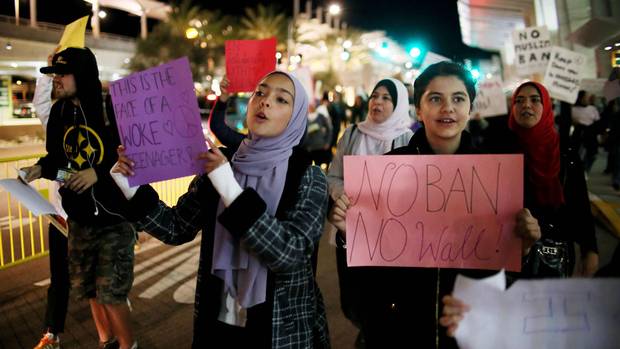The basics
- U.S. District Judge Derrick Watson on Wednesday said he would put an emergency halt on President Donald Trump’s revised immigration ban that placed temporary U.S. entry restrictions on refugees and travellers from six Muslim-majority countries.
- Mr. Trump, speaking at a Wednesday-night rally in Nashville, said he would fight the judge’s decision all the way to the Supreme Court. He also suggested that he would just reissue the original Jan. 27 order, calling the second order a “watered-down” version.
- Mr. Trump had issued the second ban on March 6. It blocked citizens of Iran, Libya, Somalia, Sudan, Syria and Yemen from applying for U.S. visas for 90 days. It also blocked all refugees from entering the country for 120 days. (You can read the full text of the presidential executive order here.)
- The policy was due to take effect at 12:01 a.m. (ET) on Thursday until the judge’s order halted it nationwide.
- The order explicitly exempted people with permanent residency status, commonly known as “green card holders,” and dual citizens with passports from a country not on the list.
- In Maryland on Wednesday, a U.S. judge also heard arguments from the American Civil Liberties Union and others who wanted to stop the order.
- Another court case – filed March 13 by the state of Washington and joined by California, Maryland, Massachusetts, New York and Oregon – also sought to stop the order.
- In theory, even if the new order had come into effect, Canadian dual citizens would have been able travel as usual, but the status of permanent residents who want to cross the border was somewhat less clear. The federal government said it would review the details of the policy to understand how Canadians were affected. Canadian citizens who have trouble crossing the border can call the government’s emergency travel number, 613-996-8885, or e-mail sos@international.gc.ca.
Watch: Sessions and Tillerson announce new executive order
How was this proposed ban different from the last one?
- Iraq off the hook: The original list of banned nations included Iraq, but the second order took it off the list after Baghdad agreed to increase co-operation with the United States on vetting its citizens for travel visas.
- Syrian refugees not singled out: The Jan. 27 order suspended refugee processing for Syrians indefinitely, whereas the new one treated Syrians like other refugees in the affected countries.
- Less chaotic rollout: The old order took effect immediately and with little warning on a Friday, leaving travellers in legal limbo midflight. This time, the White House provided a factsheet to lawmakers ahead of time and set it to take effect 10 days after the order was issued.
- More clarity for dual citizens: The Jan. 27 order created days of anxiety and confusion for citizens of Canada, Australia and other U.S. allies after the State Department and Homeland Security initially said dual citizens were affected too. Canada eventually sought and got assurances that its dual citizens could travel as usual. This time, the order explicitly excluded “any dual national” of the banned countries “when the individual is travelling on a passport issued by a non-designated country.”
What happened to the last ban?
Mr. Trump's
original order faced legal challenges in multiple courts, but the one that put it on hold nationwide
came last month from Seattle federal Judge James Robart, who issued a temporary restraining order. A higher court in San Francisco upheld Judge Robart's decision, and rather than fight it further, Mr. Trump decided to issue a new order.
More reading:
Beyond the ban: Trump's crackdown
Barring foreigners from entering the country is only part of the the Trump administration's broader restrictions on asylum seekers and prospective immigrants.
- Widening the net: Last month, Mr. Trump’s Homeland Security chief, John Kelly, issued new orders that broadened the kinds of immigrants, both undocmented and legal, to be considered as priority targets for deportation.
- Law enforcement: Orders from Mr. Trump gave law-enforcement agencies broader powers to use “expedited removals,” deportations without hearings in an immigration court. The President’s orders also allowed for up to 10,000 more immigration agents and 5,000 more border guards.
- A possible olive branch: On Feb. 28, Mr. Trump suggested he’d be open to overhauling immigration laws so that undocumented immigrants who hadn’t committed serious crimes would have a path to citizenship.
The bigger picture for Canada
Mr. Trump's immigration policies have alarmed would-be immigrants and asylum seekers from the countries his executive order targeted, and an increasing number are turning to Canada instead.
In recent months, border communities in Quebec and Manitoba have seen more and more crossings by asylum seekers in remote fields and forests. To circumvent Canada's Safe Third Country Agreement with the United States – which requires Canada to turn back asylum seekers from the U.S. if they sought asylum there first – many are crossing on foot in rural areas, risking frostbite and exhausting journeys so they can seek asylum on the Canadian side once authorities arrest them.
Border agencies, the RCMP and immigration officials have been running scenarios to prepare for an even bigger northward influx when the weather warms up this spring. Federal cabinet ministers are due to discuss the issue in-depth this week.
More reading:
With reports from Adrian Morrow, Evan Annett, Reuters, Associated Press and The Canadian Press
COMMENT AND ANALYSIS
CANADA IN THE TRUMP ERA: MORE GUIDES FROM THE GLOBE











